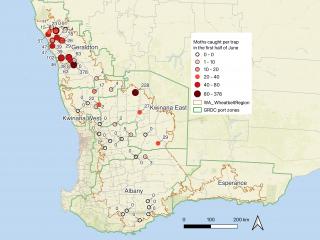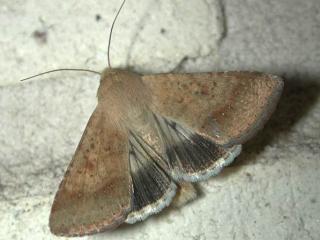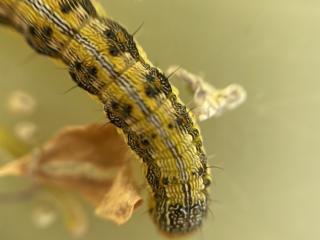Native budworm moths and caterpillars are being found early
- Geraldton port zone
- Kwinana east port zone
Native budworm moths migrate long distances annually from the north and eastern pastoral areas down and west into the grainbelt.
DPIRD’s native budworm moth traps have been set up early again this year for most grainbelt regions. Initial results indicate that budworm moth movements have begun early this year for the Geraldton and Kwinana East port zones.
Growers should be vigilant for this pest but not alarmed.
As part of co-investments with DPIRD, GRDC and iMapPESTS projects, DPIRD staff have been setting up the native budworm pheromone moth trapping network along with Mingenew Irwin Group, West Midlands Group, Liebe Group and South East Agronomy Services. Results captured by traps set up a couple weeks ago across a number of locations can be seen in the map below.

Over the last few weeks many of the traps have caught varying numbers of budworm moths. Native budworm moth trap captures over the previous two-week period include; Beacon (228 moths), Irwin (102), Eradu (78), Mingenew (64), Nabawa east (47), Dandanning (27), Miling (17), and Maya (4).
This indicates budworm moths have begun to migrate into the grain growing areas, mainly in the northern and northeastern grainbelt, and are likely to have started laying eggs onto crops.
From July onwards farmers are encouraged to check lupin, canola and pulse crops for the presence of budworm caterpillars.
A farmer near Mingenew recently sweep netted an early flowering canola crop and found one budworm caterpillar in five lots of 10 sweeps.
Native budworm moths lay white spherical eggs (0.5mm) singly, mostly near the top of the plant. The eggs darken as they mature and tiny caterpillars hatch after about seven days.
The small caterpillars will cause minor leaf damage that is not obvious, such as tiny holes chewed into leaves. So they can initially go unnoticed if crops aren’t being checked with a sweep-net. The young caterpillars feed on leaf or pod material for about two weeks before they become large enough (5mm long) to be noticed in the crop.
However, as the caterpillars get larger in the coming weeks they can cause severe damage particularly if they coincide with pulse crops budding, flowering or early pod formation.
It takes a further four weeks until they are fully grown (40mm) which is about seven weeks from the time of egg laying. These development times are based on average spring temperatures, and while temperatures are still relatively warm in the northern agricultural region these development times will be extended in areas experiencing cooler winter temperatures.
Detailed information on this pest can be found at the department’s Management and economic thresholds for native budworm.
Pesticide options for the control of native budworm can be found in DPIRD’s 2022 Winter Spring Insecticide Guide.
For more information contact Technical Officer Alan Lord, South Perth on +61 (0)8 9368 3758 or +61 (0)409 689 468.
Article authors: Alan Lord (DPIRD South Perth) and Dustin Severtson (DPIRD Northam).


